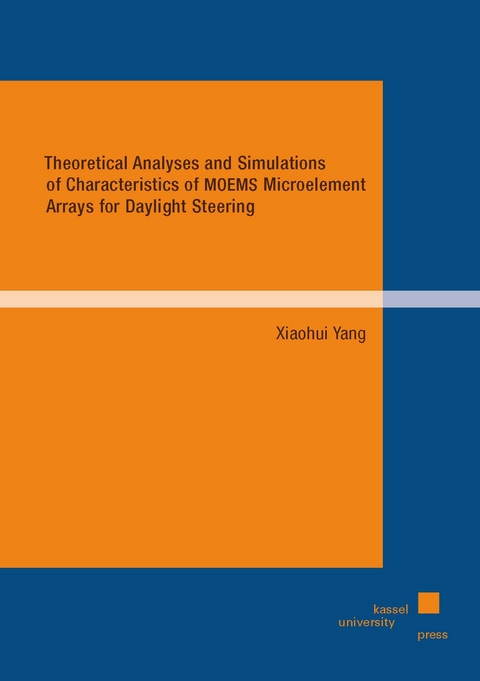
Theoretical Analyses and Simulations of Characteristics of MOEMS Microelement Arrays for Daylight Steering
Seiten
2024
Kassel University Press (Verlag)
978-3-7376-1182-4 (ISBN)
Kassel University Press (Verlag)
978-3-7376-1182-4 (ISBN)
The integration of MOEMS microelement arrays into smart glass for light steering shows promising features and valuable advantages in terms of energy conservation, enhancing lighting conditions, and improving human comfort. This study explores various actuation solutions and concludes that electrostatically actuated MOEMS devices from INA offer rapid actuation speed, minimum energy consumption, long lifetime and high stability. The static and dynamic characteristics of MOEMS devices, encompassing stressgradient-based curling, electrostatic actuations, pull-in phenomena, vibrations, material impacts, and the intriguing Casimir effects in MOEMS, are significantly affected by many structural and material parameters. All these have been delved into by theoretical model calculations. Firstly, the curling of multi-layer is addressed using the proposed analytical methods of equivalences of bending stiffness and curling moment. Then, several solutions are
selected to calculate the capacitance and pull-in voltage of rectangular microcantilevers incorporating fringe field effects. The analysis of electrostatic actuation on the planarized microelement involves integrating the equivalent moment of non-uniformly distributed electrostatic forces to estimate the pull-in voltage. Afterwards, the fundamentals of dynamic behaviours, such as the vibration and Eigenfrequency, are provided. The material effects on the characteristics of the MEMS devices are then analysed. In addition, theoretical modelling methods are employed to approximate the potential Casimir forces between paired microelements. These characteristics are also performed and verified by COMSOL 5.6 simulations, and many results agree with the results from analytic formula (including approximations). Several conclusions are briefly given here: (i) the curling axis is the most important parameter for curling, and it is mainly related to the sub-layer thicknesses; (ii) the pullin
voltage of microelements is affected by the length, thickness and Young’s modulus, and for different geometries the degree of influence varies; (iii) the actuation time for microcantilevers is affected by the length, thickness, mass density and Young’s
modulus in decreasing order of importance; (iv) the pull-in voltage and actuation time show opposite trends for the same parameter variations; (v) Al is the best metal for our electrostatic MOEMS; (vi) Casimir force is able to strongly attach two curled microelements. While this study provides already valuable insights into MOEMS microelement arrays, further refinement of theoretical methods and simulation models is essential to achieve better agreement with experimental observations.
selected to calculate the capacitance and pull-in voltage of rectangular microcantilevers incorporating fringe field effects. The analysis of electrostatic actuation on the planarized microelement involves integrating the equivalent moment of non-uniformly distributed electrostatic forces to estimate the pull-in voltage. Afterwards, the fundamentals of dynamic behaviours, such as the vibration and Eigenfrequency, are provided. The material effects on the characteristics of the MEMS devices are then analysed. In addition, theoretical modelling methods are employed to approximate the potential Casimir forces between paired microelements. These characteristics are also performed and verified by COMSOL 5.6 simulations, and many results agree with the results from analytic formula (including approximations). Several conclusions are briefly given here: (i) the curling axis is the most important parameter for curling, and it is mainly related to the sub-layer thicknesses; (ii) the pullin
voltage of microelements is affected by the length, thickness and Young’s modulus, and for different geometries the degree of influence varies; (iii) the actuation time for microcantilevers is affected by the length, thickness, mass density and Young’s
modulus in decreasing order of importance; (iv) the pull-in voltage and actuation time show opposite trends for the same parameter variations; (v) Al is the best metal for our electrostatic MOEMS; (vi) Casimir force is able to strongly attach two curled microelements. While this study provides already valuable insights into MOEMS microelement arrays, further refinement of theoretical methods and simulation models is essential to achieve better agreement with experimental observations.
| Erscheinungsdatum | 11.06.2024 |
|---|---|
| Verlagsort | Kassel |
| Sprache | englisch |
| Maße | 148 x 210 mm |
| Gewicht | 198 g |
| Themenwelt | Technik ► Elektrotechnik / Energietechnik |
| Schlagworte | Actuation time • Casimir effect • Electrostatic MOEMS microelement • Material effect • Pull-in voltage |
| ISBN-10 | 3-7376-1182-3 / 3737611823 |
| ISBN-13 | 978-3-7376-1182-4 / 9783737611824 |
| Zustand | Neuware |
| Haben Sie eine Frage zum Produkt? |
Mehr entdecken
aus dem Bereich
aus dem Bereich
Kolbenmaschinen - Strömungsmaschinen - Kraftwerke
Buch | Hardcover (2023)
Hanser (Verlag)
49,99 €


